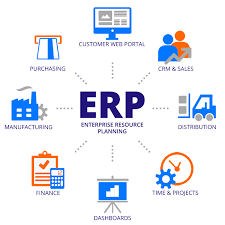The Implementation stages of ERP application and It Advantages

Abstract:
Enterprises Resource Planning (ERP) system
has become the standard for organizations to achieve collectiveness and better integration
within a business set units/department. The ERP system creates the platform for
integration of all business processes that guaranty immediate tracking of the business
growth. For Large organization with multiple office locations, benefited more on
ERP platforms as it integrates all their offices business processes on a real-time
basis that give managers and top Executive an overall performance of the company
or a snapshot of the company activities. It also provides the decision-makers quicker
analysed information from their desktop to reach a conclusive decision for the smooth
running of the organization. It helps Management to control better and reposition
the organization trend of doing things as its scoop information from various departments.
This article will enable scholars to understand how ERP is implemented and its benefit
for any organization setting.
References:
[1].
Pienaar et al
(2008). The Executive's guide to setting strategy for selecting, implementing
and operating ERP. Third Edition. IPlan Industrial Engineers.
[2].
Chen, I., J.,
(2001), "Planning for ERP system: analysis and future trend":
Business Process Management. Journal, Vol 7 No. 5, 2011, pp.374-386. © MCB
University Press, 1463-7154.
[3].
Addo-Tenkorang,
R. and Helo, P. (2011), "Enterprises Resource Planning (ERP): A Review
Literature Report': Proceeding of the World Congress of Engineering and
Computer Science 2011, Vol. II. WCECS 2011, October 19-21, 2011, San Francisco,
USA.
[4].
Uwizeyemungu and
Raymond, (2005), "Essential Characteristics of an ERP System:
Conceptualisation and Operationalisation": Journal of information and organizational
sciences, Volume 29, Number 2 (2005).
[5].
Moon, Y., (2007),
" Enterprises Resource Planning (ERP): A Review of the Literature"(2007).
Mechanical and Aerospace Engineering Paper 4. http://surface.syr.edu/mae/4.
[6].
Botta-Genoulaz et
al. (2005), " A survey on the recent research literature on ERP
system": Computers in Industry 56 (2005) 510-522.
[7].
Raguz, I., V.,
(2010). "ERP Concept for Enterprises Management and Knowledge Management
Era, New Trends in Technologies: Control, Management, Computational
Intelligence and Network Systems, Meng Joo Er (Ed), ISBN: 978-953-307-203-5.
[8].
Davenport, T. H.
(1998). Putting the enterprise into the enterprise system. Harvard business
review. 76(4), 121-131.
[9].
Marnewick, C.,
and Labuschagne, L. (2005). A conceptual model for enterprise resource planning
(ERP). Information Management & Computer Security. 13(2), 144-155.
[10]. Arif, M., Kulonda, D. J., Proctor, M., and Williams,
K. (2004). Before you invest: An illustrated framework to compare conceptual
designs for an enterprise information system. Information Knowledge Systems
Management. 4(2), 119-135.
[11]. Cobarsí, J., Bernardo, M., and Coenders, G. (2008).
Campus information systems for students: classification in Spain. Campus-wide
information systems. 25(1), 50-64.
[12]. Rashid, M., A., (2001), "The Evolution of ERP
Systems: A Historical Perspective".
[13]. Clark et al. (2014), "Beyond ERP New Technology,
new options: PWC, Strategy& Formerly Boozs & Company. www.strategyand.pwc.com.
[14]. Gil et al. (2009), "Evaluation and Trends of
Information Systems for Business Management: The M-Business. A Review":
Dyna, Year 77, No. 163. Pp. 181-193. Medellin, September, 2010. ISSN 0012-7353.
[15]. Zornada, L., and Velkavrh, T. B. (2005). Implementing
ERP systems in higher education institutions. Paper presented at the 27th
International Conference on Information Technology Interfaces, 2005.
[16]. Seng Woo, H. (2007). Critical success factors for
implementing ERP: the case of a Chinese electronics manufacturer. Journal of
manufacturing technology management. 18(4), 431-442.
[17]. Azevedo et al. (2012), " Advantages, Limitations
and Solutions in the use of ERP (Enterprises Resource Planning)- A Case Study
in the Hospitality Industry", Procedia Technology 5 (2012) 264-272.
[18]. Ziemba and Oblak, (2013), "Critical Success
Factors for ERP Systems Implementation in Public Administration":
Interdisciplinary Journal of Information, Knowledge, and Management, Volume 8,
2013.
[19]. Credit Recovery Agency (Report 2015), www.thecrasl.com/stastical-data/on-SL.

